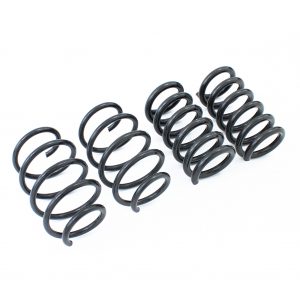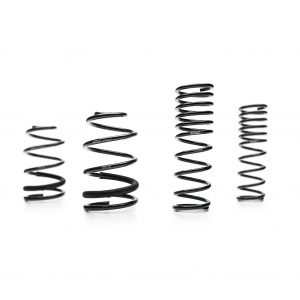Linear Vs. Progressive Springs: Which is Better for Your Car?
Linear Vs. Progressive Springs: Which is Better for Your Car?
We previously had a brief overview on suspension that covered lowering springs, coilovers, and air suspension. For most, lowering springs will be the best option since they are the least expensive, work with other factory parts, and are easy to install. But, there are different types of lower springs out there. The biggest distinction among them is linear vs progressive springs. Here we’ll go over each type and help determine which is better for your car.
Coil Springs
Before explaining the difference between these different types, let’s first examine the spring itself. What is its purpose and how does it work.
A spring can come in different types. Here we’re going to limit it specific to a coil spring. A coil spring’s job in the suspension system is a storage of energy. Whenever you go over a bump, the spring compresses. This is important since without the spring or any suspension, the ride would directly mimic the road surface. That would be incredibly uncomfortable. After the spring compresses and the bump has passed, the energy is released. This is where the damper or shock absorber comes into play. If you had only the spring, that stored energy from hitting the bump would oscillate the spring between compression and expansion in diminishing amplitudes until that energy was spent. If you’ve ever been in a car with failed dampers that bounces over every bump you know the feeling! The damper is in place to absorb this energy and transfer it to heat. This is done with a piston inside of a cylinder filled with a fluid. The piston moves up and down in the fluid absorbing the energy from the spring limiting the bouncing rebound. Now that we understand the spring and its relationship with the damper, let’s consider the spring rate.
Spring Rate
A spring rate is the amount of weight in pounds it takes to compress the spring 1″. For example, if a spring is 14″ inches long, we add 150 pounds on top of the spring, and it then compresses 1″, the spring rate of the spring is 150 lb/in. This could also be referred to as a 150 pound spring which is just an abbreviation for the lb/in unit. With that, we know that the higher the number of the spring rate the more weight it will take to compress it. Springs with a higher spring rate will result in a stiffer ride and allow less body roll.
There are some physical characteristics that can help gauge the spring’s rate. Springs that have tightly wound coils will typically have a lesser spring rate and feel softer. Coils spread further out will typically have a higher spring rate and be more firm.
There are many different vehicle applications out there. Whether or not you want a more firm or a softer spring will depending on the goals you have with your vehicle. Depending on what you’re trying to accomplish you may even want varying rates with the springs you’re running. It’s very common to have significantly different spring rates between the front and rear. Many oval track racers even use different springs rates from side to side. With that in mind, let’s go over some of the specific differences between linear and progressive springs.
Linear Springs

A linear spring is the more simple of the two types. Its spring rate is uniform through most of the compression range. With a linear 150lb 14″ spring, using our example above, each 150 lbs will compress the spring 1″.
This is typically better for most motorsports applications. This is due to the linear rate being more predictable as it is the same throughout.
Progressive Springs

Progressive springs are a little more complicated. There are two different types of progressive springs; a constantly increasing rate spring and a dual rate spring.
A constantly increasing rate spring is less common in racing applications and is typically used in areas for load compensation. These are typically a supplement to the main suspension spring. For example, if you have an old Mercedes wagon that will see significantly variable loads in the rear cargo area, a constantly increasing progressive spring would be ideal. These types are springs are identifiable with their continuously variable spacing between the coils.
The other type of progressive spring which is a lot more common is the dual rate spring. Dual rate springs are essentially two linear springs one on top of the other with a short transition area in between. These springs are also easily identified because they will typically have a loosely wound section and one tightly wound section.
This packaging of a dual rate progressive spring is typically ideal for the weekend warrior that wants the car to look and feel aggressive but wants to retain streetablility and comfort. It offers a lower ride height, increased stiffness through hard cornering, and a more comfortable ride over a stiffer linear spring. The softer portion of the dual rate is there to soak up the bumps and pot holes on your commute. If you’re driving hard, pulling lateral gs compressing the suspension, the firmer rate steps in to keep you planted.
Which is Better?
The main takeaway is that there is no one magic spring for any application. As with most things in automotive performance, there is always a trade-off. Each spring will work best within a certain range for a specific application. The best things to consider when getting lowering springs would be to first determine what exactly you’re wanting to accomplish. If you’re like most and just want something to improve the handling of your daily driver, any decent name off the shelf spring will likely work just fine. COBB Tuning has several spring applications for your supported vehicle.
Also check out How to Bleed Your Brakes yourself and Cross Drilled vs Slotted Rotors.

Leave a Reply